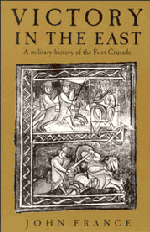Book contents
- Frontmatter
- Contents
- List of figures
- Acknowledgements
- List of abbreviations
- 1 The roots of victory
- 2 War in the West
- 3 Campaigns, generals and leadership
- 4 Preparations and prelude
- 5 The size of the crusader army
- 6 The first enemy: the Turks of Asia Minor
- 7 The second enemy: the siege of Antioch
- 8 The siege of Antioch: crisis and delivery
- 9 The siege of Antioch: victory
- 10 Divisions
- 11 Jerusalem: triumphant ending
- 12 Perspectives
- Appendix: A note on the sources
- Select bibliography
- Index
7 - The second enemy: the siege of Antioch
Published online by Cambridge University Press: 03 May 2011
- Frontmatter
- Contents
- List of figures
- Acknowledgements
- List of abbreviations
- 1 The roots of victory
- 2 War in the West
- 3 Campaigns, generals and leadership
- 4 Preparations and prelude
- 5 The size of the crusader army
- 6 The first enemy: the Turks of Asia Minor
- 7 The second enemy: the siege of Antioch
- 8 The siege of Antioch: crisis and delivery
- 9 The siege of Antioch: victory
- 10 Divisions
- 11 Jerusalem: triumphant ending
- 12 Perspectives
- Appendix: A note on the sources
- Select bibliography
- Index
Summary
At Antioch the army of the First Crusade had arrived in the fractured borderlands of Islam – an area of acute political fragmentation where small political units proliferated. It is tempting to consider the victory an inevitable triumph of the unified and zealous crusaders over a disunited and poorly prepared Islam. It is true that some of the Islamic powers took little notice of the crusade and continued with their internecine conflicts. To later generations of Muslim writers, raised on the spirit of Holy War, this was shameful, but at the time it was to be expected because of political circumstances. However, too much scorn should not be poured on the Islamic powers of North Syria. The major cities of the area were a firm underpinning for its defence; the siege of Antioch would last nine months. Three major battles would be fought in efforts to lift the crusader siege and there were innumerable minor ones. For the crusaders it was a terrible struggle, a military epic indeed, the success of which was a more than adequate demonstration that their journey was the work of God. Political fragmentation in this area was real, but even so military resistance was considerable (see fig. 3).
- Type
- Chapter
- Information
- Victory in the EastA Military History of the First Crusade, pp. 197 - 235Publisher: Cambridge University PressPrint publication year: 1994



